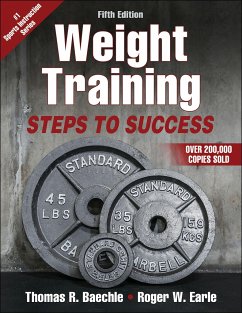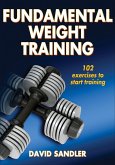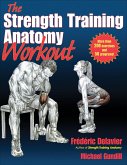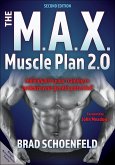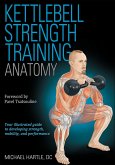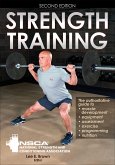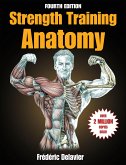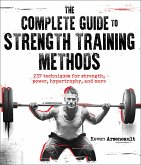- Broschiertes Buch
- Merkliste
- Auf die Merkliste
- Bewerten Bewerten
- Teilen
- Produkt teilen
- Produkterinnerung
- Produkterinnerung
"Weight Training" will help improve muscular endurance, build strength, increase muscle mass, and improve body composition. From the fundamentals of weight training to the specifics of designing an individualized program, this full-color guide covers every facet of weight training, including eating smart to maximize results.
Andere Kunden interessierten sich auch für
![Fundamental Weight Training Fundamental Weight Training]() David SandlerFundamental Weight Training16,99 €
David SandlerFundamental Weight Training16,99 €![The Strength Training Anatomy Workout The Strength Training Anatomy Workout]() Frederic DelavierThe Strength Training Anatomy Workout30,99 €
Frederic DelavierThe Strength Training Anatomy Workout30,99 €![The M.A.X. Muscle Plan 2.0 The M.A.X. Muscle Plan 2.0]() Brad J. SchoenfeldThe M.A.X. Muscle Plan 2.028,99 €
Brad J. SchoenfeldThe M.A.X. Muscle Plan 2.028,99 €![Kettlebell Strength Training Anatomy Kettlebell Strength Training Anatomy]() Michael HartleKettlebell Strength Training Anatomy25,99 €
Michael HartleKettlebell Strength Training Anatomy25,99 €![Strength Training Strength Training]() Strength Training25,99 €
Strength Training25,99 €![Strength Training Anatomy Strength Training Anatomy]() Frederic DelavierStrength Training Anatomy33,99 €
Frederic DelavierStrength Training Anatomy33,99 €![The Complete Guide to Strength Training Methods The Complete Guide to Strength Training Methods]() Keven ArseneaultThe Complete Guide to Strength Training Methods33,99 €
Keven ArseneaultThe Complete Guide to Strength Training Methods33,99 €-
-
-
"Weight Training" will help improve muscular endurance, build strength, increase muscle mass, and improve body composition. From the fundamentals of weight training to the specifics of designing an individualized program, this full-color guide covers every facet of weight training, including eating smart to maximize results.
Hinweis: Dieser Artikel kann nur an eine deutsche Lieferadresse ausgeliefert werden.
Hinweis: Dieser Artikel kann nur an eine deutsche Lieferadresse ausgeliefert werden.
Produktdetails
- Produktdetails
- Verlag: Human Kinetics Publishers
- 5 ed
- Seitenzahl: 288
- Erscheinungstermin: 18. Oktober 2019
- Englisch
- Abmessung: 294mm x 218mm x 2mm
- Gewicht: 930g
- ISBN-13: 9781492586951
- ISBN-10: 1492586951
- Artikelnr.: 56790576
- Herstellerkennzeichnung
- Libri GmbH
- Europaallee 1
- 36244 Bad Hersfeld
- gpsr@libri.de
- Verlag: Human Kinetics Publishers
- 5 ed
- Seitenzahl: 288
- Erscheinungstermin: 18. Oktober 2019
- Englisch
- Abmessung: 294mm x 218mm x 2mm
- Gewicht: 930g
- ISBN-13: 9781492586951
- ISBN-10: 1492586951
- Artikelnr.: 56790576
- Herstellerkennzeichnung
- Libri GmbH
- Europaallee 1
- 36244 Bad Hersfeld
- gpsr@libri.de
Thomas R. Baechle, EdD, CSCS,*D-R, NSCA-CPT,*D-R, has been an author or editor of 17 books on strength training, some on which have been translated into 10 languages. Perhaps most noteworthy are his publication efforts as the editor of the first three editions of the National Strength and Conditioning Association’s Essentials of Strength Training and Conditioning (which he also contributed several chapters to) and the coeditor of the first edition of NSCA’s Essentials of Personal Training. He has published 80 articles or chapters and has made over 170 presentations related to strength training, fitness, and wellness, 40 of which were international presentations. Baechle is one of the founding fathers of the NSCA and was the association’s second president and director of education. During his time as executive director of the NSCA Certification Commission, he was instrumental in establishing the CSCS and NSCA-CPT certifications as the premier certification credentials. Baechle has received over 40 awards for his contributions to local, national, and international professional organizations and institutions, including recognitions from Human Kinetics and American Alliance for Health, Physical Education, Recreation and Dance (AAHPERD). He was honored with an Outstanding Teaching Award from Creighton University, where he served as chair of the exercise science and pre–health professions department for 38 years. He currently holds the rank of professor emeritus. His NSCA awards and recognitions include Region IV NSCA Strength Coach of the Year in 1982 and 1983; Strength and Conditioning Professional of the Year in 1984; President’s Award in 1986, 1991, and 1993; Lifetime Achievement Award in 1998; Service Award from the NSCA Certification Commission in 2007; NSCA Hall of Fame in 2017; and the Pioneer Award and the Alvin Roy Career Achievement Award in 2019. Roger W. Earle, MA, CSCS,*D, NSCA-CPT,*D, has over 30 years of experience as a personal fitness trainer, competitive sport conditioning coach, and behavior modification facilitator for people of all ages and fitness levels. In addition to training clients in person and online, he lectures at national and international conferences about weight management, exercise motivation, and the creation of personalized exercise and training programs. Earle is a senior acquisitions editor in the Trade and Professional division at Human Kinetics, the world’s largest publisher of sport and exercise books and online products. He is a coauthor, coeditor, or contributor for 10 fitness- or resistance-training-related books, including Fitness Weight Training and EuropeActive's Foundations for Exercise Professionals. Earle was previously the associate executive director and the director of exam development for the NSCA Certification Commission, a role in which he was responsible for reviewing and editing the CSCS and NSCA-CPT exams and writing study resources, as well as coediting the first edition of NSCA’s Essentials of Personal Training and the second and third editions of Essentials of Strength Training and Conditioning. Before working at the NSCA, Earle was the head strength and conditioning coach at Creighton University in Omaha, Nebraska, for 10 years and was a faculty member in their exercise science and athletic training department for 6 years.
Step 1. Equipment Options and Proper Use Guidelines
Step 2. Stretching, Lifting, and Spotting Techniques
Step 3. Selecting Exercises and Determining Training Loads
Step 4. Chest Exercise Options and Loading Guidelines
Step 5. Back Exercise Options and Loading Guidelines
Step 6. Shoulder Exercise Options and Loading Guidelines
Step 7. Upper Arm Exercise Options and Loading Guidelines
Step 8. Leg Exercise Options and Loading Guidelines
Step 9. Core Exercise Options and Loading Guidelines
Step 10. Completing Your First Workout
Step 11. Applying Program Design Principles
Step 12. How to Manipulate the Program Design Variables to Maximize Results
Step 13. How to Design Your Own Basic Program
Step 14. Designing a Sport-Specific Training Program
Step 15. Designing a High-Intensity Interval Training Program
Step 2. Stretching, Lifting, and Spotting Techniques
Step 3. Selecting Exercises and Determining Training Loads
Step 4. Chest Exercise Options and Loading Guidelines
Step 5. Back Exercise Options and Loading Guidelines
Step 6. Shoulder Exercise Options and Loading Guidelines
Step 7. Upper Arm Exercise Options and Loading Guidelines
Step 8. Leg Exercise Options and Loading Guidelines
Step 9. Core Exercise Options and Loading Guidelines
Step 10. Completing Your First Workout
Step 11. Applying Program Design Principles
Step 12. How to Manipulate the Program Design Variables to Maximize Results
Step 13. How to Design Your Own Basic Program
Step 14. Designing a Sport-Specific Training Program
Step 15. Designing a High-Intensity Interval Training Program
Step 1. Equipment Options and Proper Use Guidelines
Step 2. Stretching, Lifting, and Spotting Techniques
Step 3. Selecting Exercises and Determining Training Loads
Step 4. Chest Exercise Options and Loading Guidelines
Step 5. Back Exercise Options and Loading Guidelines
Step 6. Shoulder Exercise Options and Loading Guidelines
Step 7. Upper Arm Exercise Options and Loading Guidelines
Step 8. Leg Exercise Options and Loading Guidelines
Step 9. Core Exercise Options and Loading Guidelines
Step 10. Completing Your First Workout
Step 11. Applying Program Design Principles
Step 12. How to Manipulate the Program Design Variables to Maximize Results
Step 13. How to Design Your Own Basic Program
Step 14. Designing a Sport-Specific Training Program
Step 15. Designing a High-Intensity Interval Training Program
Step 2. Stretching, Lifting, and Spotting Techniques
Step 3. Selecting Exercises and Determining Training Loads
Step 4. Chest Exercise Options and Loading Guidelines
Step 5. Back Exercise Options and Loading Guidelines
Step 6. Shoulder Exercise Options and Loading Guidelines
Step 7. Upper Arm Exercise Options and Loading Guidelines
Step 8. Leg Exercise Options and Loading Guidelines
Step 9. Core Exercise Options and Loading Guidelines
Step 10. Completing Your First Workout
Step 11. Applying Program Design Principles
Step 12. How to Manipulate the Program Design Variables to Maximize Results
Step 13. How to Design Your Own Basic Program
Step 14. Designing a Sport-Specific Training Program
Step 15. Designing a High-Intensity Interval Training Program

